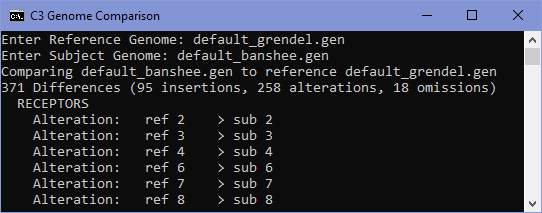[Originally written July 11 2020]
There are no brakes on the genetics train. I am absolutely hooked!
And so I thought perhaps I should take another page from Discover Albia’s book and examine new Norns and Grendels for mutations, starting with the twins. I wasn’t really happy with any of the existing means of comparing C3 genomes, though, as I found the outputs either unhelpful or downright unreadable. So, being me, I wrote a script. Two scripts, actually, which leverage the official gendiff.exe tool. The first is a python script that parses the gendiff output into something a little better suited to my own tastes. The second is a batch script that wraps the two tools together with an in-script prompt for the file names (so I can just double click the icon rather than having to give it command line arguments). The output, both in the window and in a text file, tells me what’s being compared to what, and how many differences there are. It then lists, grouped by gene type, each gene that was changed, in an easy to read format. Because I found the tools that try to compare the genes themselves to be practically unreadable, this strips it down to the bare minimum – whether it’s an insertion, alteration, or omission, and what the gene number in the reference and/or subject genome is, so I can go look them up in the more comfortable setting of the Genetics Kit.
Since the twins, despite appearances, are not 100% Banshee Grendel, I decided the best way to inaugurate my new script was to find out what the difference between the two official Grendel breeds are.
371 differences? Yeah okay no thanks. I’ll just compare the kids to both parent genomes and just look at the results that are different from both breeds, since those will be the mutations. First, I compared them to each other and confirmed that they have 0 differences and therefore are indeed identical twins (sex is not genetic in creatures so it’s entirely possible to have identical twins of opposite sex).
I then compared Sebastian (although it really doesn’t matter which one) to both default genomes. The twins are definitely more Banshee than Jungle Grendels, with only 54 difference from the former and 345 differences from the latter. Of the 54 difference from Banshee Grendels, only 14 were also listed as differences from Jungle Grendels (meaning the remaining 40 differences were simply cases of taking after the Jungle Grendel side of the family).
All 14 were alterations. One was the Genus, which stores the parents’ monikers. 8 were pigment and pigment bleed changes that were so small as to be completely undetectable to the human eye. Two were pose genes, which I’m unable to make sense of – they affect the poses associated with slapping and getting hurt, but how, I don’t know. And two seemed to be false positives – one apparently identical to the normal Banshee Grendel, and the other apparently the same across all three.
Organ: “Brain”, Tissue: “Tissue 10: decn”, Locus: “Neuron(10) state(0)”. Chemical: “Sleepase”.
Organ: “Creature”, Tissue: “Drive levels”, Locus: “WAIT”. Chemical: “Sleepase”.
But boy was the one that remained a challenge to figure out! The sample rate and output function were unchanged, so I left those out. This gene appears to be linked to the Floating Loci organ, which, according to the Creatures Wiki, does a variety of maintenance functions. Of particular relevance here is the specific note that it “produces sleepase when the creature is asleep or has decided to sleep.” Since the base genomes have this emitter linked to the decision lobe, that makes sense.
Further research indicates that Sleepase converts the sleepiness backup to normal sleepiness. Backup drives, apparently, are basically how the game suppresses less important drives without actually losing the value – it just moves the drive into a backup chemical.
If I’m understanding this correctly, then deciding to sleep will not help convert sleepiness backup into sleepiness. Instead, this would happen based on the “WAIT” drive. That being said, the emitter that produces sleepase in response to actually being asleep is intact, so I don’t foresee this being a problem. I did a little more digging and found that the need to wait is linked to “patience” which seems to be involved in the instincts that get creatures to wait for lifts to arrive and such. I’ve seen creatures expressing patience once or twice before, and wondered what that was about – so that’s another mystery solved!

No comments:
Post a Comment